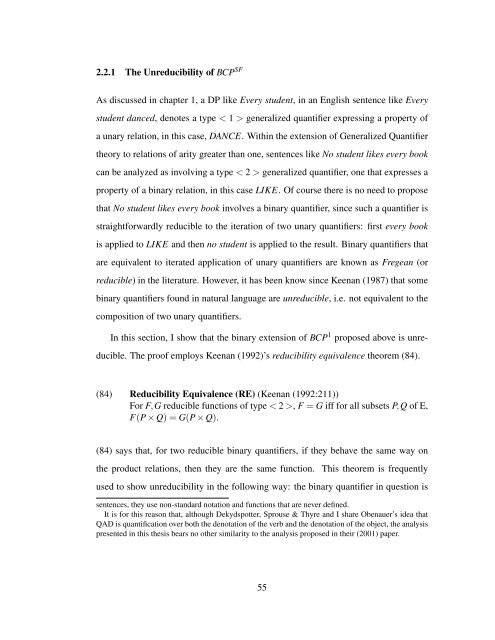Formal Approaches to Semantic Microvariation: Adverbial ...
Formal Approaches to Semantic Microvariation: Adverbial ...
Formal Approaches to Semantic Microvariation: Adverbial ...
Create successful ePaper yourself
Turn your PDF publications into a flip-book with our unique Google optimized e-Paper software.
2.2.1 The Unreducibility of BCP SF<br />
As discussed in chapter 1, a DP like Every student, in an English sentence like Every<br />
student danced, denotes a type < 1 > generalized quantifier expressing a property of<br />
a unary relation, in this case, DANCE. Within the extension of Generalized Quantifier<br />
theory <strong>to</strong> relations of arity greater than one, sentences like No student likes every book<br />
can be analyzed as involving a type < 2 > generalized quantifier, one that expresses a<br />
property of a binary relation, in this case LIKE. Of course there is no need <strong>to</strong> propose<br />
that No student likes every book involves a binary quantifier, since such a quantifier is<br />
straightforwardly reducible <strong>to</strong> the iteration of two unary quantifiers: first every book<br />
is applied <strong>to</strong> LIKE and then no student is applied <strong>to</strong> the result. Binary quantifiers that<br />
are equivalent <strong>to</strong> iterated application of unary quantifiers are known as Fregean (or<br />
reducible) in the literature. However, it has been know since Keenan (1987) that some<br />
binary quantifiers found in natural language are unreducible, i.e. not equivalent <strong>to</strong> the<br />
composition of two unary quantifiers.<br />
In this section, I show that the binary extension of BCP 1 proposed above is unreducible.<br />
The proof employs Keenan (1992)’s reducibility equivalence theorem (84).<br />
(84) Reducibility Equivalence (RE) (Keenan (1992:211))<br />
For F,G reducible functions of type < 2 >, F = G iff for all subsets P,Q of E,<br />
F(P × Q) = G(P × Q).<br />
(84) says that, for two reducible binary quantifiers, if they behave the same way on<br />
the product relations, then they are the same function. This theorem is frequently<br />
used <strong>to</strong> show unreducibility in the following way: the binary quantifier in question is<br />
sentences, they use non-standard notation and functions that are never defined.<br />
It is for this reason that, although Dekydspotter, Sprouse & Thyre and I share Obenauer’s idea that<br />
QAD is quantification over both the denotation of the verb and the denotation of the object, the analysis<br />
presented in this thesis bears no other similarity <strong>to</strong> the analysis proposed in their (2001) paper.<br />
55
















